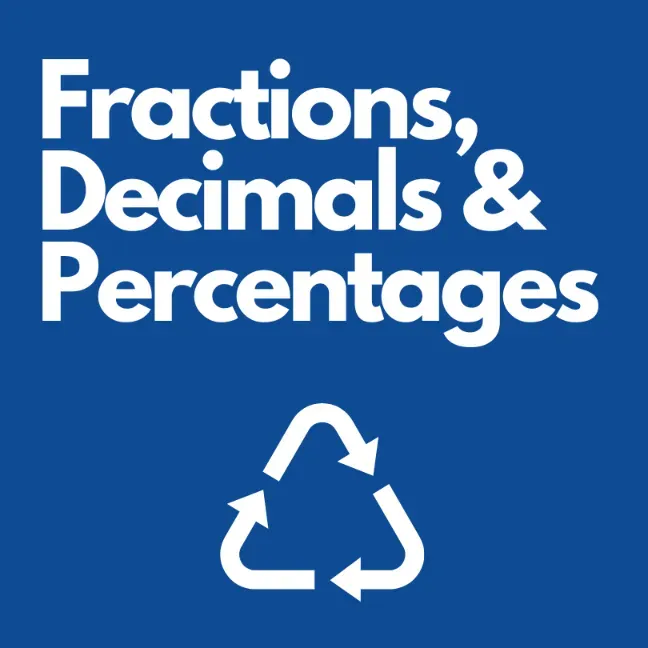Fraction to Decimal Calculator
Enter a fraction using positive or negative numbers
Related Fraction, Decimal & Percent Calculators
See all maths calculators
Fraction to Decimal Conversion Guide
The Fraction to Decimal Converter is a valuable tool that allows you to transform fractions into their precise decimal equivalents. This comprehensive guide will walk you through the process of using such a converter, explain the concepts behind fraction-to-decimal conversion, provide practical examples, and offer insights into common pitfalls and real-world applications.
Understanding Fractions and Decimals
Before diving into the conversion process, let's clarify some key concepts:
Fractions
A fraction represents a part of a whole. It consists of a numerator (top number) and a denominator (bottom number). For example, in the fraction 3/4, 3 is the numerator and 4 is the denominator.
Decimals
A decimal is a way of writing fractions whose denominators are powers of ten. For example, 0.75 is equivalent to 75/100 or 3/4.
Converting Fractions to Decimals
The process of converting a fraction to a decimal involves a simple division:
- Divide the numerator by the denominator.
For example, to convert 3/4 to a decimal:
- 3 ÷ 4 = 0.75
Therefore, 3/4 = 0.75
Examples of Fraction to Decimal Conversions
Let's look at a table of examples:
| Fraction | Conversion Process | Decimal Result |
|---|---|---|
| 1/2 | 1 ÷ 2 | 0.5 |
| 1/4 | 1 ÷ 4 | 0.25 |
| 3/4 | 3 ÷ 4 | 0.75 |
| 1/3 | 1 ÷ 3 | 0.333... |
| 2/5 | 2 ÷ 5 | 0.4 |
| 5/4 | 5 ÷ 4 | 1.25 |
| 1/8 | 1 ÷ 8 | 0.125 |
| 7/10 | 7 ÷ 10 | 0.7 |
Common Mistakes to Avoid
When using a Fraction to Decimal Converter, be aware of these common pitfalls:
-
Inverting the fraction: Ensure you're dividing the numerator by the denominator, not the other way around.
-
Rounding errors: Be cautious with repeating decimals (like 1/3), which may need rounding for practical purposes.
-
Misinterpreting improper fractions: Remember that improper fractions (where the numerator is larger than the denominator) will result in decimals greater than one.
-
Confusion with percentages: Don't confuse decimal results with percentages; remember that percentages are out of 100.
-
Omitting trailing zeros: While not always necessary, including trailing zeros can help clarify precision (e.g., writing "0.50" instead of "0.5").
Practical Applications
Understanding how to convert fractions to decimals has numerous real-world applications:
Academic Grading
Test scores often involve fractions that are easier to interpret as decimals.
Example: If a student scores 18/20 on a test, this converts to a decimal score of 0.9.
Finance and Investing
Many financial calculations require decimals rather than fractions for precision.
Example: If an investment grows by a factor of 3/2, this is equivalent to multiplying by a decimal factor of 1.5.
Statistics and Data Analysis
Data analysis often involves converting fractions to decimals for clarity and ease of comparison.
Example: If a survey shows that 3/5 of respondents prefer option A, this can be expressed as a decimal preference of 0.6.
Cooking and Nutrition
Recipe adjustments and nutritional information often require fraction-to-decimal conversions.
Example: If a recipe calls for adding sugar until it reaches half its original volume (1/2), this can be represented as reducing by a decimal factor of 0.5.
Real World Analogies (RWA)
To better understand fraction to decimal conversions, consider these real-world analogies:
-
Pizza Slices:
- If you eat half (1/2) of a pizza, you've consumed it as a decimal portion of 0.5.
- If you eat three-quarters (3/4) of a pizza, that's equivalent to consuming it as a decimal portion of 0.75.
-
Time Management:
- If you spend one-third (1/3) of your day sleeping, that's approximately equivalent to spending it as a decimal portion of about 0.333...
- If you work for two-fifths (2/5) of the day, that's equivalent to spending it as a decimal portion of about 0.4.
-
Sports Statistics:
- If a basketball player makes seven-tenths (7/10) of their free throws, their shooting percentage is represented as a decimal portion of about 0.7.
- If a baseball team wins half (1/2) their games, their win rate is represented as a decimal portion of about 0.5.
-
Sales and Discounts:
- If an item is discounted by one-fifth (1/5) off its original price, it's on sale for four-fifths or represented as paying about a decimal portion of about .8.
- If you've saved three-eighths (3/8) toward your purchase goal, you're represented as being about .375 toward reaching your goal in terms of savings.
These real-world analogies help to ground abstract fraction-to-decimal conversions in concrete, everyday situations, making them easier to understand and remember.
Using Technology: Fraction to Decimal Converters
While it's important to understand the manual process, Fraction to Decimal Converters can quickly perform conversions for complex fractions or when precision is needed beyond simple mental math:
- Verify the input format required by the converter.
- Double-check your entries for accuracy.
- Understand the output format provided by the converter (number of decimal places).
- Use the results judiciously, especially in professional or academic contexts where showing your work may be required.
The Importance of Understanding Fraction to Decimal Conversions
Converting fractions to decimals is an essential skill that extends beyond simple arithmetic and is crucial for many fields including academics, finance, statistics, and everyday calculations. By mastering these conversions, you enhance your numerical literacy and problem-solving skills.
Conclusion
Using a Fraction to Decimal Converter to transform fractions into their precise decimal equivalents is an invaluable skill that enhances your ability to work with numerical data effectively across various contexts—whether you're balancing budgets or analyzing data sets—understanding this process can improve your mathematical capabilities and practical problem-solving skills.
Remember that while converters are powerful tools for quick calculations or handling complex numbers efficiently—understanding underlying concepts remains crucial; practice manual conversions alongside using converters helps develop deep understanding between fractions & decimals relationships!
Key Takeaways
- Understand that converting fractions involves dividing numerators by denominators.
- Be aware common mistakes like inverting fractions or rounding errors.
- Recognize practical applications across academics finance statistics cooking etc.
- Use real-world analogies help better understand remember conversion processes.
- While converters helpful understanding manual processes crucial developing mathematical intuition.
- Remember improper fractions yield decimals greater than one; repeating decimals may require rounding precision purposes!
By mastering fraction-to-decimal conversions you'll have powerful tools at disposal understanding working numerical data various real-world scenarios!

